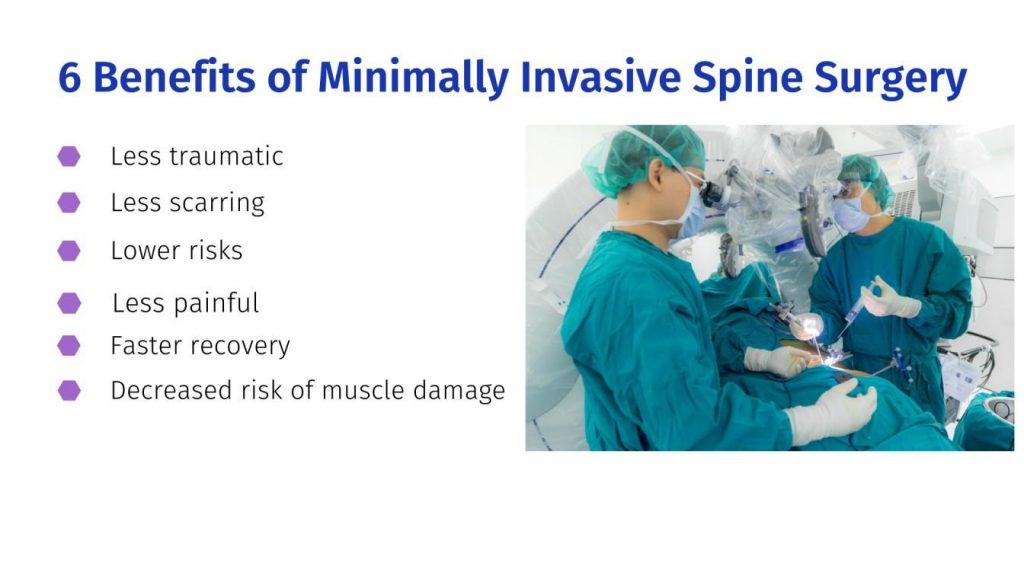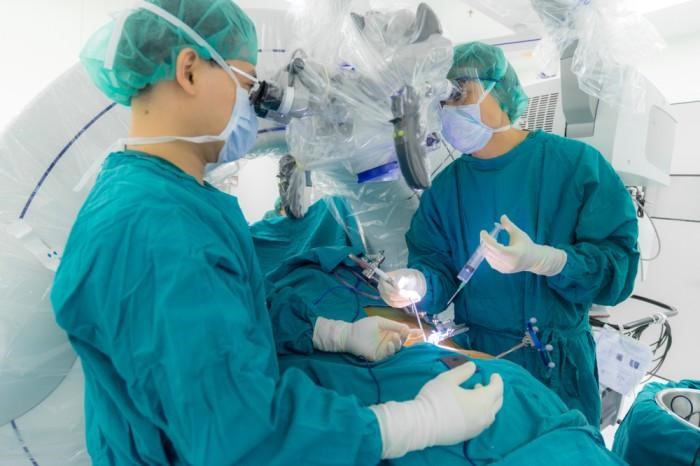If you’re thinking about having spine surgery, see if minimally invasive spine surgery (MISS) is a suitable fit for you. MISS has various benefits to regular open spine surgery.
What is Minimally Invasive Spine Surgery?
Your surgeon makes a single large incision (cut) into your skin in a “conventional” open surgical procedure. A considerable quantity of muscle and surrounding soft tissue is distributed or pushed out of the way or removed from the bone to let your surgeon see the surgery site properly. This might lead to further muscle injury and discomfort following surgery.
Your surgeon will make one or more tiny incisions (approximately 12 inches each) into your skin during minimally invasive surgery. To allow the surgeon to operate in a narrower operational field, a tiny metal tube or endoscope is inserted into the incision. When compared to a single lengthy incision, working through tiny wounds produces far less harm to muscles and soft tissues.
How Minimally Invasive Spine Surgery Works?
Due to the location of the spinal nerves, vertebrae, and discs deep within the body, any strategy to obtain access to the spinal region necessitates the removal of muscle tissue Making tiny incisions and putting equipment and/or microscopic video cameras through them is a common way to do this. Lasers are rarely employed in MIS operations, contrary to common assumptions.
Conditions Treated Using MIS Procedures
- Degenerative disc disease
- Herniated disc
- Spinal infections
- Spinal instability including spondylolisthesis
- Lumbar spinal stenosis.
- Vertebral compression fractures
- Spinal fusion is a procedure that is commonly used to treat degenerative or “slipped” discs.
- Spinal deformities such as scoliosis
- Decompression of spinal tumours.
Minimally invasive surgical methods can be quicker, safer, and need less recovery time than open spine surgery. Here are some of the advantages of minimally invasive spine surgery versus regular surgery:
6 Benefits of Minimally Invasive Spine Surgery

1. Less traumatic
When you have surgery, your body is put under a lot of stress. You must also recuperate from the muscle and tissue damage induced by the treatment in addition to the problem being addressed. Because minimally invasive surgery does not include muscle cutting, your body can concentrate on repairing the disc, nerves, and vertebrae rather than the muscle.
2. Less scarring
Many people prefer minimally invasive surgery for aesthetic reasons in addition to the health benefits. Scarring is minimised to a minimum with only a few minor incisions. Patients may be left with many big scars after standard spine surgery. That is no longer the case thanks to minimally invasive spine surgery. Whether you’re concerned about scars, find out if you qualify for less invasive surgery.
3. Lower risks
Minimally invasive surgery, in general, carries a low risk. The health benefits are also obvious when compared to standard surgery. In contrast to massive holes in the back and neck, minimally invasive spine surgery employs tiny incisions. As a consequence, infection risk is greatly decreased, and blood loss is minimal. Also, with minor incursion, muscle injury is minimal to non-existent.
Furthermore, compared to traditional surgery, the quantity of anaesthetic utilised is usually smaller. This lowers the chance of problems from anaesthesia during surgery and recovery.
4. Less painful
Spinal operations are frequently used to relieve spinal nerve compression that causes discomfort in the patient’s back, arms, legs, or other parts of the body. Traditional, open surgery, on the other hand, might cause severe discomfort due to the wider incision utilised in this procedure. Patients who undergo minimally invasive spinal surgery have reduced discomfort throughout the procedure. They may also have reduced post-operative discomfort, lowering the need for potentially harmful painkillers.
5. Faster recovery
The primary purpose of spine surgery is to relieve pain that has been bothering you for months or years. Open surgery causes more discomfort and necessitates a lengthy recovery period, which may include long-term rehabilitation. However, minimally invasive surgery speeds up the recovery period and allows you to resume your normal activities sooner.
6. Decreased risk of muscle damage
The spine can be supported and stabilised via minimally invasive spine surgery. Open surgery causes muscles to be pulled away from the afflicted portion of the spine, causing muscular and soft tissue injury. Minimally invasive surgery, on the other hand, does not entail the same amount of muscle cutting or tugging. As a result, the danger of muscle and surrounding region injury is reduced.
So, if you believe you need extensive spine surgery, it’s possible that you don’t. You may be confident that cutting-edge technology will be used to execute delicate spine treatments with more accuracy, enhanced safety, and better results in terms of mobility, function, and quality of life, thanks to substantial breakthroughs in the field of minimally invasive surgery (MIS).
The neurosurgeons at every orthopaedic hospital in Dubai employ the most cutting-edge minimally invasive procedures and technology to help patients recover faster and return home sooner. Innovative minimally invasive treatments have pioneered improved approaches for the surgeon to reach the spine, as well as promise a smoother healing process.


